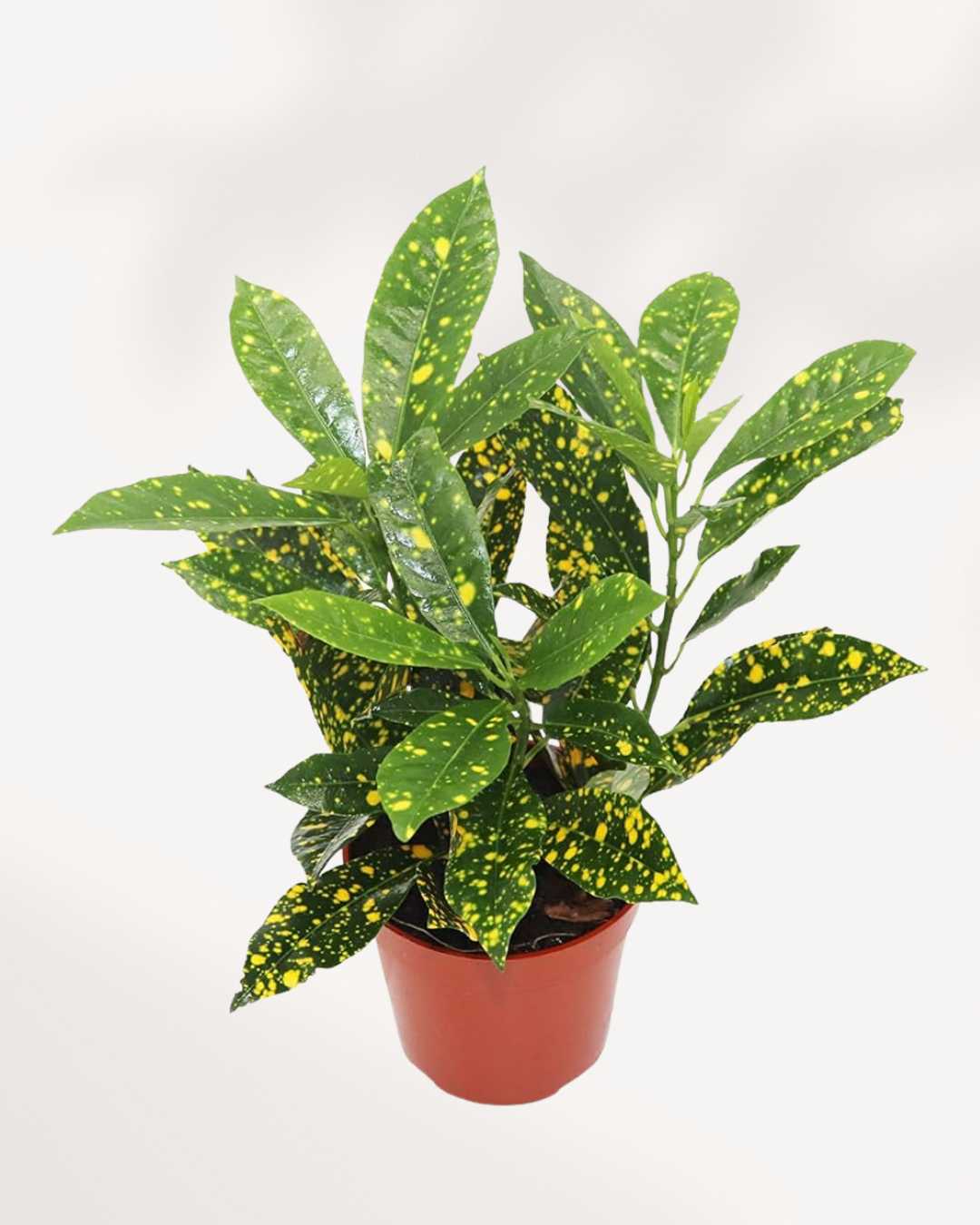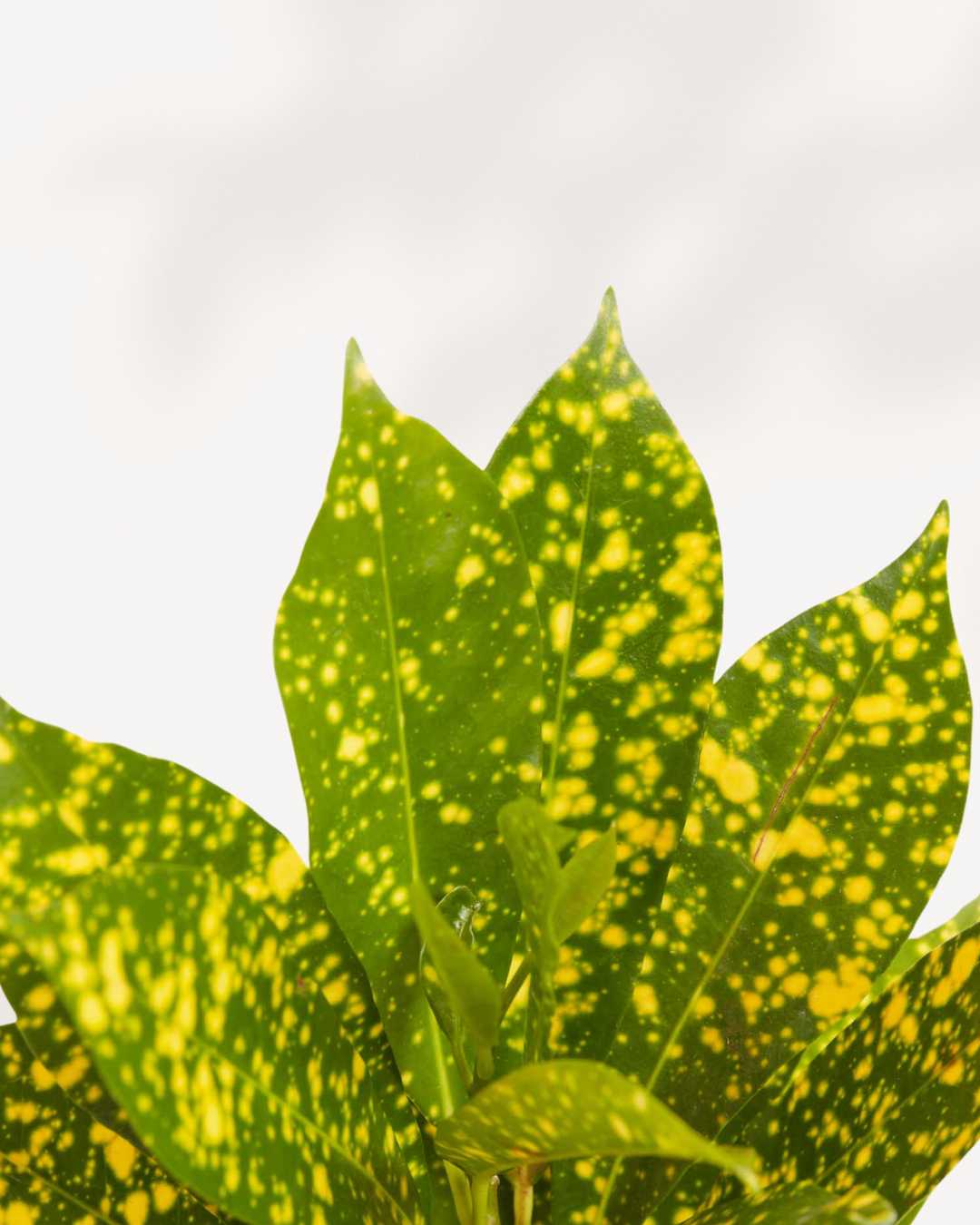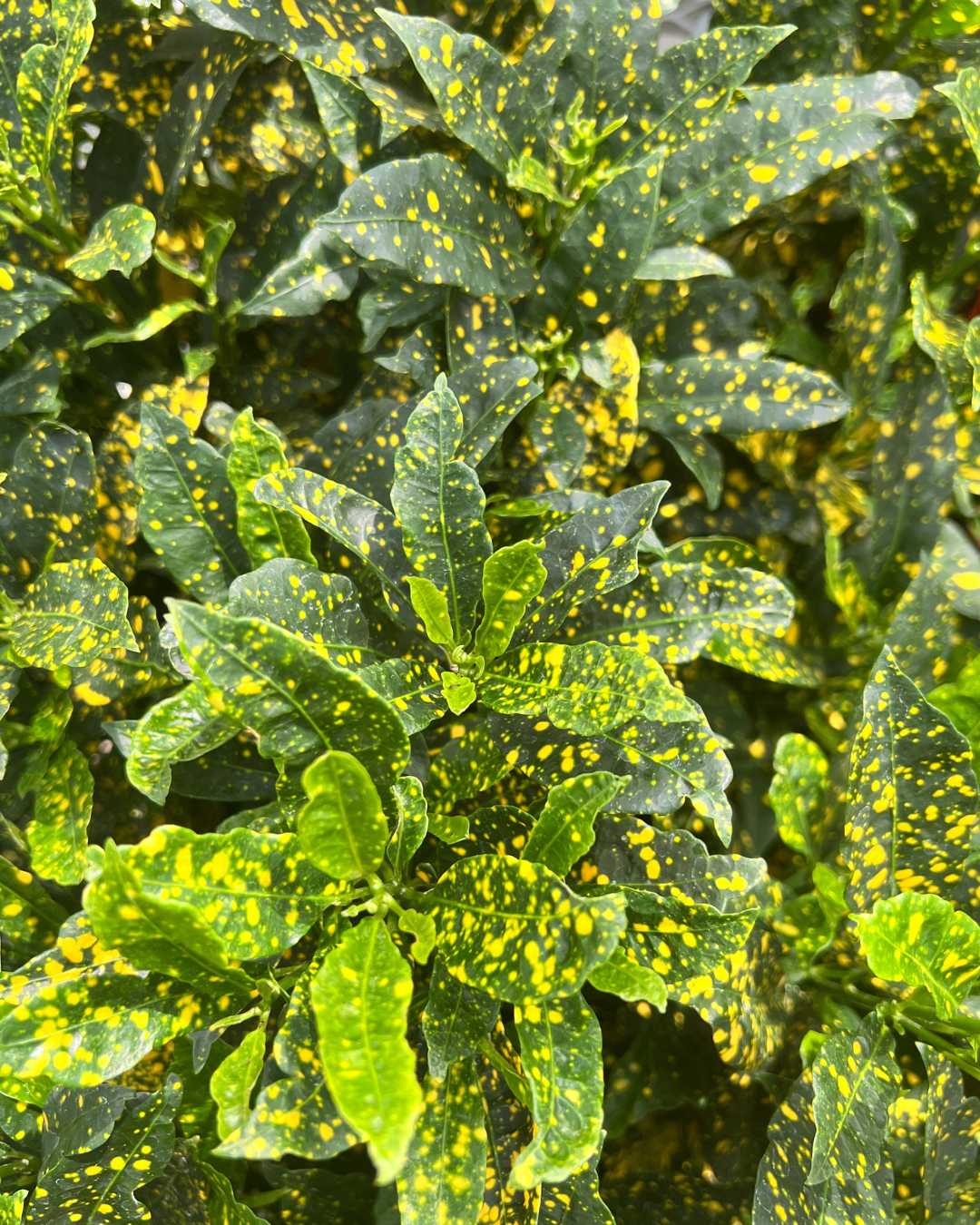Couldn't load pickup availability
Croton Gold Dust – Speckled Tropical Radiance
Croton Gold Dust is a bold and eye-catching variety renowned for its vibrant green foliage speckled with brilliant yellow spots. Perfect for adding a burst of tropical color to any indoor space, this croton stands out with its dynamic patterns and low-maintenance care—ideal for both seasoned plant enthusiasts and beginners.
Why You'll Love Croton Gold Dust
- ✨ Stunning speckled yellow spots on lush green leaves
- 🌞 Thrives in bright, indirect light for optimal color display
- 💧 Low-maintenance care perfect for busy lifestyles
- 🌱 Adds a vibrant tropical accent to any room
Common Names
- Croton Gold Dust
- Gold Dust Croton
- Speckled Croton
Botanical Classification
- Kingdom: Plantae
- Order: Malpighiales
- Family: Euphorbiaceae
- Genus: Codiaeum
- Species: Codiaeum variegatum
Native Habitat
Crotons originate from the tropical regions of Southeast Asia and the Pacific Islands. They thrive in warm, humid conditions and have been adapted for indoor cultivation worldwide.
Historical and Cultural Significance
Celebrated for their dramatic foliage and vibrant colors, crotons have been used for centuries as ornamental plants. They symbolize good fortune and are often featured in festive décor to bring a touch of tropical exuberance.
Why It’s So Popular
- Adds a dynamic burst of color to any space
- Low-maintenance and easy to grow indoors
- Enhances air quality and tropical appeal
- Perfect as a focal point or accent plant in modern interiors
What Does It Look Like?
Appearance
Croton Gold Dust is distinguished by its striking foliage—lush green leaves speckled with golden-yellow spots create a vibrant, textured pattern that commands attention.
Growth Habit
This variety grows as a compact shrub with a bushy, dense canopy. Its steady growth and bold coloration make it a perfect choice for brightening up indoor spaces.
Popular Croton Varieties
Petra Croton
- Features broad leaves with bold red, yellow, and green veins.
Croton Banana
- Known for its long, banana-shaped leaves in vibrant yellow and green hues.
Croton Magnificent
- Bold leaves with green, yellow, and orange speckles.
Croton Sunshine
- Bright yellow leaves that bring a sunny touch to any space.
Common Pests
Spider Mites
Spider mites can cause stippling and fine webbing on the leaves. Increase humidity and treat with insecticidal soap or neem oil. Learn More
Mealybugs
Mealybugs leave white, cotton-like deposits on the leaves. They can be managed with rubbing alcohol or insecticidal soap. Learn More
Frequently Asked Questions
What are the ideal light conditions for Croton Gold Dust?
It thrives in bright, indirect light while avoiding prolonged direct sunlight to prevent leaf scorching.
How often should I water Croton Gold Dust?
Water when the top inch of soil is dry—typically every 1-2 weeks, adjusting for indoor humidity.
Can Croton Gold Dust thrive indoors?
Yes, with proper light and care, it is well-suited for indoor environments.
How do I propagate Croton Gold Dust?
Propagation is usually done via stem cuttings. Allow the cuttings to callous over before planting in a well-draining medium.
Is Croton Gold Dust pet-friendly?
While generally non-toxic, it is best to keep it out of reach of pets to prevent any potential irritation.
Learn More About Croton Plant Care
For detailed care instructions and expert tips on maintaining healthy croton plants, visit our Croton Plant Care Guide.
Ready to Add a Burst of Tropical Radiance?
Bring home Croton Gold Dust today and transform your space with its bold, dynamic foliage.
Order Yours TodayHow to take care of Croton Gold Dust
Sun: Direct - Indirect
Sun: Direct - Indirect
Light: Medium - Bright
Light: Medium - Bright
Water: When top quarter dry
Water: When top quarter dry
Humidity: Any
Humidity: Any
Pet Friendly: Caution
Pet Friendly: Caution
Pro Tip
Pro Tip
Delivery Policy for Plant Condition
Delivery Policy for Plant Condition
"I have only received part of my order. What to do?
No worries if you've only got part of your order! Our plants come from different nurseries and might arrive in separate shipments, typically 1-2 days apart. It's all part of ensuring your green friends reach you in top-notch condition!
If you do not receive the remaining packages within 48 hours contact support at info@mygreenscape.ca
What is the Life Time Support?
Absolutely! Lifetime support means you can count on us whenever you have questions or uncertainties about your plant. Whether you're puzzled by its behavior or just want to ensure it's thriving, we're here for you. Connect with us on Instagram @mygreenscapeto or shoot us an email at support@mygreenscape.ca.
When it comes to our guarantee for plants shipped with standard or express, rest assured that we offer a 30-day happy healthy plant guarantee on all such shipments. This ensures that your plants are covered for 30 days after delivery, giving you peace of mind regarding their condition. If you have any concerns within this period, feel free to reach out to us for assistance.
For further details, please visit our Local Delivery, Store Pickup, Standard Shipping Guide Page.
What to expect
What to expect
Your plant will arrive in a standard nursery pot, typically 0.5" - 1" smaller than the stated size to seamlessly fit into your chosen decorative pot. Washable Paper Planter Bags are available for separate purchase.
Just like nature intended, each plant is unique, showcasing natural variations in size, shape, and characteristics. Our commitment is to deliver a plant that closely resembles the one featured on our website, matching your chosen size, and with the potential to thrive happily in your home.
Frequently Asked Questions
Frequently Asked Questions
Certainly! If you're pondering about ordering plants online, you're not alone. We've compiled the most frequently asked questions. Check out our FAQ section here for quick answers! Happy planting!
Plant & Pot Size Chart
Plant & Pot Size Chart
Choosing the right pot size for your plants can be a daunting task, especially if you're new to gardening. But fear not! Our pot sizes chart can help you find the perfect match for your plants, ensuring they have enough space to grow and thrive. With our guide, you'll be able to confidently choose the right pot size and plant variety for your gardening needs.
Plant Pot Size Guide.

| Extra Small | 7-10 cm | 2.5 - 3 inches |
| Small | 11-12 cm | 3.5 - 4 inches |
| Medium | 14-17 cm | 5 - 6 inches |
| Large | 19-21 cm | 8 - 10 inches |
| Extra Large | 24-27 cm | 12 - 14 inches |
All sizes are specified in product details.
Your Complete Guide to Pot Sizes: What Size Should You Choose?

When selecting a pot for your plant, it's important to find the right size. But with all the different options out there, how do you know which one is best? We're here to help!
MyGreenscape's pot sizes chart is a great resource for finding your perfect fit. Our easy-to-read chart takes out all the guesswork and helps you quickly choose the right size for your plant.
Smaller pots are best for seedlings or small plants just starting out. These tend to be shallow but wide, allowing enough room for the roots of the young plant but not too much where they get overcrowded. Medium-sized pots are ideal when your plant has grown from its infancy and is ready for more space. These are deeper and wider than small pots, so that it can accommodate larger root systems - making sure your plant gets enough nourishment while still giving it breathing room. Large pots are top choice if you have an established plant in need of lots of space - think trees and large shrubs! The spacious depth and width allow plenty of room for deep root systems without struggling for air or light.
No matter what size you choose, MyGreenscape has got you covered, with our pot sizes chart guaranteeing you find the perfect fit every time!
Winter Shipping Protection
Winter Shipping Protection
We take extra care with each package during the colder months. For destinations experiencing cold weather, we provide insulated packaging and heat packs as needed to protect your plants from freezing temperatures. With Winter Shipping Protection, your plants are equipped to arrive safe and sound, even in winter’s chill.
Care Guide
Care Guide
Explore essential care tips. check out our Comprehensive Resource for Indoor Plant Care.




WATERING MADE EASY
Check soil moisture before watering and use a potting mix that drains well. It’s the secret to healthy, happy plants!
Hear From Happy Plant Parents.
Who have brought Mygreenscape plants into their homes.


















